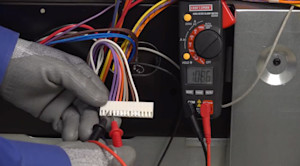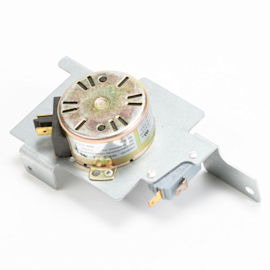F30 and F31 error code troubleshooting for ranges video


This video from Sears PartsDirect shows what to do when your range flashes an F30 or F31 error code and your oven won’t bake or broil. For Kenmore and Frigidaire ranges like this one, these codes mean that the control detects a problem with the oven temperature sensor probe. The 3 parts that can trigger this code are the oven temperature sensor probe, a wiring harness or the electronic oven control board. In this video, we’ll show you how to figure out exactly what’s wrong so you can get back to cooking.
For more DIY help with your electric or gas range, check out our repair help page for troubleshooting tips and videos, repair guides and error code charts.
Hi. Wayne here from Sears PartsDirect. Today we’re going to talk about what to do when you see the F30 or F31 code on the range display when you try baking or broiling.
For Kenmore and Frigidaire ranges like this one, these codes mean that the control detects a problem with the oven temperature sensor probe.
The 3 parts that can trigger this code are the oven temperature sensor probe, a wiring harness or the electronic oven control board.
The F30 and F31 codes differ slightly, even though they both indicate a problem with the oven temperature sensor. Specifically, the F30 code indicates the probe could be broken or unplugged or its wires could be broken or damaged.
The F31 code is similar; it indicates the probe could be broken or its wires could be pinched. Pinching can damage the sensor wires’ insulation, causing bare wire strands to short against each other or the metal cabinet.
With both codes, if you find that the sensor probe and its wiring are okay, it means the electronic control board incorrectly detected a bad sensor, and you have to replace the board.
Tools you may need
This video shows how to figure out exactly what’s wrong. You need a multimeter complete the electric checks and a nut driver to pull off the back range panels. Also, let the oven cool to room temperature if it’s still hot.
Check the wiring connections
Let’s get started. Unplug the range and pull it out so you can get to the oven temperature sensor probe and electronic oven control board on the back of the range. If you have a gas range, shut off the gas supply.
Remove the screws and pull off the top and bottom back panels.
First make sure the sensor probe is fully plugged into its wire harness. If the connection is loose, tighten the connection and reassemble the range.
Restore electrical power to the range and see if the code disappears. If it does, you fixed the problem by tightening that wire harness connection.
If the code appears, let’s check the entire sensor circuit through the purple wires that connect to the electronic oven control board.
Check the sensor circuit
Unplug the wire harness with purple wires from the electronic oven control board. With your multimeter set to check resistance, measure the resistance through the purple wires on the connection plug. It should measure around 1,080 ohms at room temperature.
If it measures near 1,080 ohms of resistance, the oven temperature sensor probe and its wiring are likely okay. But you need to test for a ground to the metal range cabinet, because a ground in the sensor wiring to the cabinet can cause the F30 or F31 code.
Check for resistance from each purple wire to metal on the back of the range. If it measures OL, there’s no short to the metal cabinet and the wiring is okay.
If it measures OL between each purple wire and the metal cabinet, replace the control board because it’s finding a problem with the wiring and sensor probe even though your checks showed they’re both okay. Here’s a video that shows you how to replace the control board.
If it measures 0 ohms of resistance between one or both purple wires and the metal cabinet, find and repair the wire damage that’s allowing bare sensor wiring to touch the metal cabinet.
Test the sensor
If the multimeter doesn’t measure near 1,080 ohms through the purple sensor wires that connect to the electronic oven control board, a broken oven temperature sensor probe or a wiring failure is causing the F30 or F31 code. Let’s check the sensor first.
Unplug the sensor from the wire harness and check the sensor resistance. If it doesn’t measure near 1,080 ohms, replace the oven temperature sensor because it has failed. Here’s a video that shows you how.
If it does measure near 1,080 ohms of resistance through the sensor, replace the wire harness because the wire harness is keeping the electronic oven control board from measuring the proper sensor resistance.
Once you replaced the problem part, reinstall the back panels and plug in the range. The error code should be gone and that means you fixed the problem and can get back to baking!
Well, we hope this video helps you out today. Check out our other videos on the Sears PartsDirect YouTube Channel and subscribe to get notifications when we post new videos.
Most common symptoms to help you fix your ranges
Choose a symptom to see related range repairs.
Main causes: broken oven door lock assembly, wiring failure, electronic control board problem…
Main causes: faulty temperature sensor, electronic control board problem, control thermostat failure, weak burner ignite…
Main causes: power supply problem, control thermostat or electronic control board failure, broken element, bad burner ig…
Main causes: food splatters, spilling food on the oven door, allowing liquid to drip through oven door vent when cleanin…
Main causes: broken broiler element, weak or broken broil burner igniter, control system failure, faulty temperature sen…
Main causes: bad bake element, broken burner igniter, control system failure, blown thermal fuse, faulty temperature sen…
Main causes: power supply failure, blown thermal fuse, bad relay control board, damaged terminal block, wiring failure…
Most common repair guides to help fix your ranges
These step-by-step repair guides will help you safely fix what’s broken on your range.

How to replace a range oven door switch
The oven door switch detects whether the oven door is closed and helps control the oven light. Replace the switch if it …

How to replace a range oven door lock assembly
Oven door not locking? You can replace the lock assembly in less than 30 minutes. Here's how.…
Effective articles & videos to help repair your ranges
Use the advice and tips in these articles and videos to get the most out of your range.

Learn how to clean and maintain your stove to keep it in top shape.…

Learn about all the convenient features on our Sears PartsDirect website that make your parts purchases easier.…

Get answers to frequently asked questions about Sears and Sears PartsDirect.…
